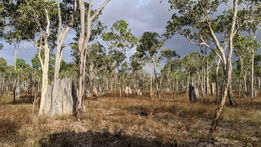Tropical Birding's Habitats of the World
'A Supplementary Website for Princeton's Habitats of the World: A Field Guide for Birders, Naturalists and Ecologists'
Biome: SAVANNA WOODLANDS
Biome Overview:
SAVANNAS AND SEASONALLY MOIST SHRUBLANDS: Habitats with an open canopy, lots of grass or shrubbery, and a strongly seasonal (usually wet-summer/dry-winter) climate. Most habitats in this category are heavily influenced by fire.

Sub-Biomes:
Open Broadleaf Woodland: Non-sclerophyllous woodlands that can have tall trees and open canopy cover. Can have many deciduous trees. Fire-tolerant.
Example: Afrotropical Guinea Savanna
Thorn Savanna: Open (tall or short) woodlands with lots of grass cover. Trees are often dominated by acacias (of various genera), many of them with spines.
Example: Neotropical Chaco Seco and Espinal
Broadleaf Sclerophyllous Savanna: Low shrublands or forests that can be thick. Tend to not
have as much grass as other savannas. Plants have thick leathery leaves, thick bark. Fire-tolerant.
Example: Neotropical Cerrado
Mixed Shrub Savanna: Thickets and low-canopy dry forest that has grass cover and a mix of
coniferous, sclerophyllous, and broadleaf shrubs or trees. Fire-tolerant.
Example: Australasian Brigalow Woodland




Latitudes and Precipitation Where this Biome Exists

Typical Fauna in this Biome


Typical Biome Habitats

























































